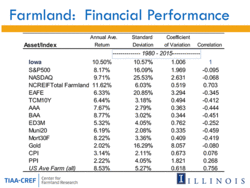
Investment in Iowa farmland and institutions' total land funds (NCREIF) consistently outpaced the stock and bond markets between 1980 and 2015. That's calculating capital gains and cash returns, minus real estate taxes. (Chart courtesy of TIAA-CREF Center for Farmland Research)
Farmland REITs Gain Ground
Wall St. Funds Flirt With Farmland
Marcia Taylor, DTN Executive Editor
LOUISVILLE, Ky. (DTN) -- Wall Street remains enamored with U.S. and international farmland, speakers at a Farm Foundation meeting in Louisville said last week. But while some funds and institutional owners have billions of dollars to spend on that romance, it will take time for them to own a significant share of the U.S. farm real estate market.
GROWTH SPURT
Since 2007, the mutual fund company TIAA-CREF has reportedly dedicated $8 billion to farmland purchases in the U.S. and overseas. Insurance companies like Prudential manage $1.2 trillion of farm assets, mostly for pension funds and institutional clients. Lenders like Bank of America also manage farmland ownership for wealthy individuals and families. That doesn't count new entrants like Farmland Partners Inc., one of the first cropland-only real estate investment trusts (REITs) that launched on the New York Stock Exchange in April 2014 and now owns about 111,000 acres of cropland in more than a dozen states. It hopes to double its footprint in the next few years.
"High-net-worth families have always known that real estate is a good place to have a chunk of your portfolio," said Corny Gallagher, a senior vice president managing the $36 billion portfolio of food, ag production and processing for Bank of America Merrill Lynch. After 47 years in banking, Gallagher still co-owns his family's sixth-generation farm in west-central Iowa.
"Yes, farmland values have come down," Gallagher said, "but in the West, land values are driven by water not by commodity prices." The price of all California commodities is down by at least 50% recently, he noted, but land with 3 acre feet of water has nearly doubled in price in that same time frame since it can sustain permanent crops.
LACK OF ALTERNATIVE INVESTMENTS
With miserable returns on conservative investments like bonds or CDs, investors will seek out farmland as an alternative because it's still a category that earns a reasonable rate of return, Gallagher added.
Bruce Sherrick, director of the University of Illinois' TIAA-CREF Center for Farmland Research, cited farmland's robust long-term performance with attracting Wall Street's attention. Between 1980 and 2015, Iowa farmland owners averaged annual returns of 10.5% (capital gains and cash rents), versus 8.17% for the S&P 500. Insurance companies and other institutions that report returns for the NCREIF index bested both of those with an average 11.62%. That was also far better than the NASDAQ index, bonds and most other conventional investments. Compared to the stock real estate crash in 2007-2008, for example, farmland looked like a safe harbor in the midst of a hurricane.
"It's clear farmland is gaining credibility as a New York asset class," Sherrick said. However, it took 10 or 15 years for shopping malls and commercial office buildings to become an individual investment category known as REITs. As a group, non-ag REITs returned an average of 12% a year since 2000, according to J.P. Morgan Asset Management, dominating the second-place finisher, high-yield bonds at 7.9%. Ag REITs hope to ride on those coattails.
Moderation in farm real estate values since 2014 only adds to farmland's appeal. "Institutional owners see the price reset as an opportunity," Sherrick said. "I expect they have money on the sidelines ready to invest when the price is right."
Paul Pittman, CEO of Farmland Partners (NYSE: FPI), stressed that institutional owners aren't typically bidding at auctions or paying the highest prices for grain-based real estate. Instead, their target sellers are heirs of farm estates who live off farm and lack an emotional attachment to the land. By the time the great-grandchildren inherit property, they never knew the original farmers. Such "remote" owners stand to inherit 280 million acres of farm real estate, Pittman estimated.
Whether institutional owners are "here today, gone tomorrow" is another issue. Pittman said his REIT intends to own farmland long term, much like insurance companies do now. However, a number of private funds need to flip property frequently to return profits to investors.
"If one of my investors wants his money back, he calls his stockbroker," Pittman said. In contrast, many private institutional investors often have a seven-year life built into their contracts, requiring land liquidation in the process. That doesn't give tenants much security.
MIXED RESULTS
While Pittman's REIT concentrates on Grain Belt farms, not all farmland REITs have enjoyed success. American Farmland (NYSE: AFCO) was launched by New York tycoons in 2009 to invest in specialty crops like irrigated California farmland and orchards. Not only have prices for nut crops swooned thanks to over planting, but so have values for drought-prone land. The REIT's share price has floundered; in April, it announced that it was considering strategic alternatives, such as a merger or sale of all or part of the company.
Farmers at the Farm Foundation forum had mixed views on the debut of a new class of absentee investors. Some worried about high turnovers of ownership. Others were open to the idea, but found the cash rents demanded by professional investors unrealistic at $4 corn.
Edwardsport, Indiana, farmer Don Villwock sought out an institutional investor to buy a farm when an 87-year-old landowner died recently. She was proud of her pioneer grandmother who ran a local grist mill at a time when women rarely owned a business in their own right, Villwock said. But 60 days after her death, her heirs wanted cash.
Villwock hoped he could entice an institutional investor to buy the farm and lease it back to him. Even if the land had sold for $8,000 an acre, the investor needed a 4% annual return, or $320 per acre. That was too rich for Villwock's current cash rent budget. Eventually, one of the parcels sold for $13,000 per acre. Villwock lost a farm he'd been leasing for years, and the potential institutional owner was priced out of the sale as well. A local wealthy investor picked up the property.
"Agriculture is facing a paradigm shift," said Villwock. "We've got a lot of aging landlords. [When they die], it's hard for nonfarm folks to keep up with the weather, the risk. They really want a cash check."
But as America's farms change hands this decade, or should existing farm operators become stressed, the question is: Who will be the next buyers?
USDA reports that only 1% of the nation's farms are owned by corporate investors now, but they currently account for 10% of production. The University of Illinois' Sherrick expects some funds to grow aggressively in a farm real estate downturn, since they see real estate corrections as a buying opportunity. But a transition to more absentee ownership of farmland will be slow.
"Only 1% of U.S. farmland turns over in any given year in arms' length transactions, so it will take some time to change to institutional ownership," Sherrick said.
Marcia Taylor can be reached at [email protected]













